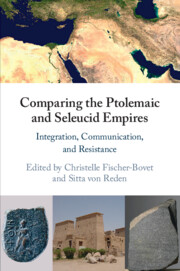Book contents
- Comparing the Ptolemaic and Seleucid Empires
- Comparing the Ptolemaic and Seleucid Empires
- Copyright page
- Contents
- Contributors
- Preface
- Note on Abbreviations
- Maps
- Introduction
- Part I Cities, Settlement and Integration
- Part II Communication and Exchange
- Part III Collaboration, Crisis, and Resistance
- Chapter 8 Legitimizing the Foreign King in the Ptolemaic and Seleucid Empires
- Chapter 9 Antiochus III, Ptolemy IV, and Local Elites
- Chapter 10 Regional Revolts in the Seleucid and Ptolemaic Empires
- Bibliography
- Index
Chapter 10 - Regional Revolts in the Seleucid and Ptolemaic Empires
from Part III - Collaboration, Crisis, and Resistance
Published online by Cambridge University Press: 17 September 2021
- Comparing the Ptolemaic and Seleucid Empires
- Comparing the Ptolemaic and Seleucid Empires
- Copyright page
- Contents
- Contributors
- Preface
- Note on Abbreviations
- Maps
- Introduction
- Part I Cities, Settlement and Integration
- Part II Communication and Exchange
- Part III Collaboration, Crisis, and Resistance
- Chapter 8 Legitimizing the Foreign King in the Ptolemaic and Seleucid Empires
- Chapter 9 Antiochus III, Ptolemy IV, and Local Elites
- Chapter 10 Regional Revolts in the Seleucid and Ptolemaic Empires
- Bibliography
- Index
Summary
This chapter compares the Great Revolt of the Thebaid (206–186 BC) and the Maccabean Revolt (starting in the 160s), which took place in a period of important social, economic, and political change. Though the events preceding each revolt differ markedly (the founding of a polis in Jerusalem, for example, has no counterpart in the Thebaid), Honigman and Veïsse emphasize multiple interconnected internal and external factors, including political miscalculations and expensive wars. They observe that it was not domination itself, but the way it was played out at a given moment that triggered revolts, especially a tighter royal control over land and taxation. Though they stressed that using sources of a rather different nature requires caution, their systematic examination of the causes of the revolts, of the ideological discourses, of the reaction of the government, and their aftermaths help to identify different strategies applied by each regime in different regions. They show how history, memories, and the structure of the territory made indirect rule of Judea conceivable for both Seleucid kings and the locals, while it was unthinkable for the Ptolemies and the “rebels” in the Thebaid.
Keywords
- Type
- Chapter
- Information
- Comparing the Ptolemaic and Seleucid EmpiresIntegration, Communication, and Resistance, pp. 301 - 328Publisher: Cambridge University PressPrint publication year: 2021
- 14
- Cited by

